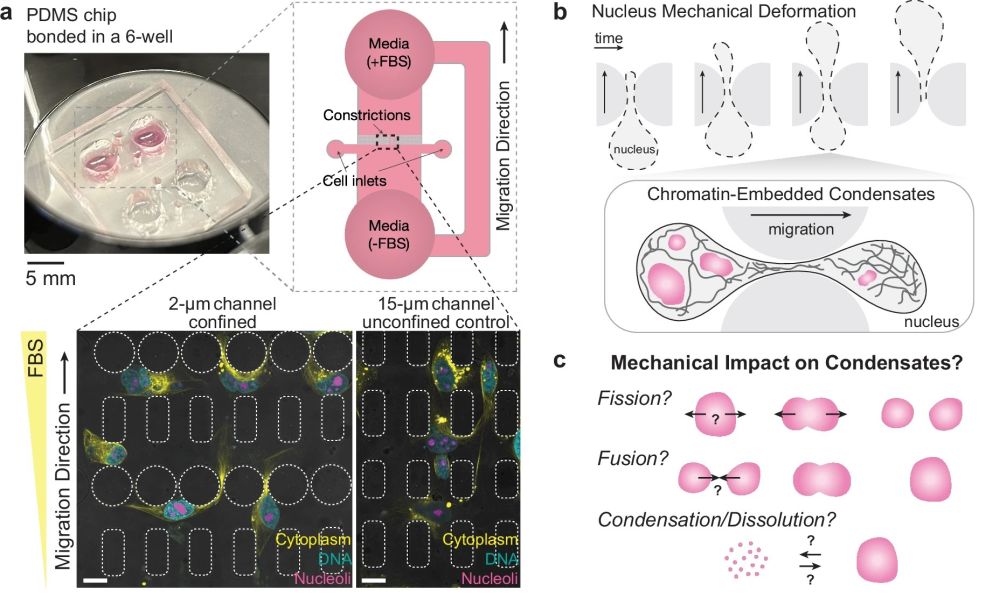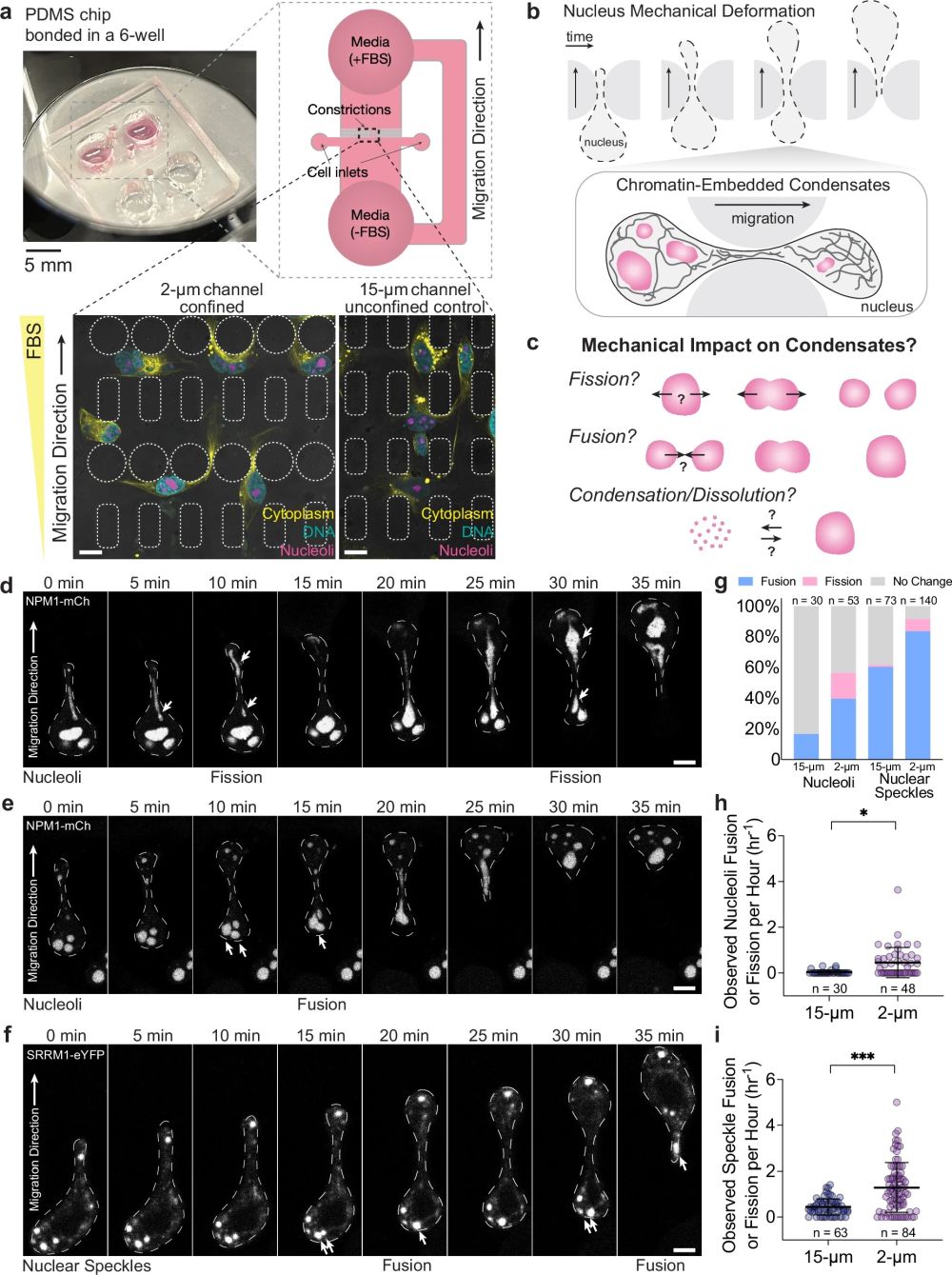
25 Nov Chromatin Dynamics and Nuclear Condensate Behavior: Insights From a Microfluidic Assay
Understanding how cellular components, especially chromatin and nuclear condensates, respond to mechanical forces during confined migration is crucial. This is particularly relevant in the context of cancer metastasis, where cells must navigate through tight interstitial spaces, imposing severe mechanical deformations on the nucleus. These deformations could significantly affect the behavior of nuclear condensates, which are crucial for cellular functions such as transcription and RNA splicing. Luckily, microfluidic chips offer the exact right tool for analyzing chromatin compaction throughout confined migration.,
“Here, we show that nuclear mechanical deformation during confined migration of human breast cancer cells impacts chromatin-embedded condensates. Using a microfluidics confined migration assay, we show that endogenous and synthetic condensates deform significantly due to stresses generated in the surrounding chromatin network.“, the authors explained.
The study presented employs a microfluidic device to mimic the confined spaces encountered by migrating cells in vivo. By observing human breast cancer cells during migration through these microfluidic constrictions, the research aims to elucidate how chromatin compaction influences the dynamics of nuclear condensates.
Using PDMS for microfabrication of microfluidic devices with channel heights mimicking the constriction of interstitial spaces, the study tracked the migration of MDA-MB-231 breast cancer cells. The cells were observed migrating from an area without fetal bovine serum (FBS) to an area supplemented with FBS, promoting chemotaxis through the constricted spaces. Live-cell fluorescence microscopy was employed to visualize and quantify the mechanical deformations of the nucleus and the resulting dynamics of nuclear condensates.

“a top, Schematics of the imaging-compatible microfluidic device in a 6-well plate for studying cancer cell confined migration. a bottom, Human breast cancer cells MDA-MB-231 directionally migrate in the microfluidic device in the presence of an FBS gradient. Left: confined area with 2 µm wide channels where the cell nucleus undergoes mechanical deformation. Right: control area with a 15 µm wide channel where no major deformation of the cell nucleus is observed. Cyan: H2B-mGFP. Magenta: nucleoli marked by NPM1-mCherry. Yellow: cytoplasm marked by CellBrite dye. Scale bar: 15 µm. b Illustration of nuclear bodies in the nucleus undergoing mechanical deformation throughout the confined-migration event. Dashed line: outlines of the nucleus during confined migration. Zoom-in: various nuclear condensates (magenta) embedded in the chromatin environment (black line). c Schematics of different hypothetical outcomes of mechanical deformation impacting phase-separated assemblies inside the cell nucleus. Deformation can result in fusion and fission of nuclear condensates as the nucleus progresses through constriction, or lead to nuclear protein condensation or dissolution. d Confined migration leads to nucleoli fission. Representative examples of NPM1-mCherry labeled nucleoli. Scale bar: 5 µm. e Representative examples of NPM1-mCherry labeled nucleoli fusing during confined migration. Arrows: fusion events. Scale bar: 5 µm. f Representative examples of SRRM1-eYFP labeled nuclear speckles fusing during confined migration. Arrows: fusion events. Scale bar: 5 µm. g Distribution of observed outcomes of nucleoli and nuclear speckles in a 150-minute time interval, with n indicating the number of nucleoli or nuclear speckles that can undergo fusion, fission, or no change in its dynamics. h, i Observed fusion and fission events per hour for nucleoli and nuclear speckles during confined migration. n = 30 cells expressing NPM1-mCherry in 15 µm channels, n = 48 cells expressing NPM1-mCherry in 2 µm channels, and n = 63 cells expressing SRRM1-eYFP in 15 µm channels, n = 84 cells expressing SRRM1-eYFP in 2 µm channels, across N = 3 independent experiments. Error bars show standard deviation, and statistical significance *p = 0.04, ***p < 0.001 by one-way ANOVA for multiple comparisons (two-tailed).” Reproduced from Zhao, J.Z., Xia, J. & Brangwynne, C.P. Chromatin compaction during confined cell migration induces and reshapes nuclear condensates. Nat Commun 15, 9964 (2024). under a CC BY 4.0 Attribution 4.0 International license
The research revealed that during confined migration, nuclear deformation led to differential chromatin behavior in the advancing versus the trailing region of the nucleus. The trailing half showed an increase in chromatin heterogeneity, which facilitated the formation of new condensates due to shifts in the binodal phase boundary. Specific observations included:
- Nucleoli and nuclear speckles within the nucleus undergoing significant deformation, fusion, and fission.
- A pronounced increase in condensate dynamics in the trailing half of the nucleus, suggesting a region-specific response to mechanical stress.
- The formation of new condensates in the trailing half of the nucleus, particularly in areas with increased chromatin compaction and heterogeneity.
The study demonstrates that mechanical stress during confined migration induces significant changes in nuclear condensate behavior, with chromatin compaction and heterogeneity playing critical roles. These findings suggest that nuclear condensates are highly sensitive to the mechanical environment, potentially influencing cellular functions through their dynamic reorganization in response to mechanical cues. This insight into the cellular mechanosensitivity has profound implications for understanding the physical influences on cellular behavior during cancer metastasis and other scenarios involving confined cell migration.
“Our biophysical model provides an exciting opportunity for future work to investigate phase separation as a global mechanosensing mechanism in cells under mechanical force in various physiological and disease conditions. Future experiments combining confined migration experiments with microfluidics-based single-cell genomics assay are needed to interrogate the role of condensation on mechanosensitive gene expression and broader function.“, the authors concluded.
Figures are reproduced from Zhao, J.Z., Xia, J. & Brangwynne, C.P. Chromatin compaction during confined cell migration induces and reshapes nuclear condensates. Nat Commun 15, 9964 (2024). https://doi.org/10.1038/s41467-024-54120-5 under a CC BY 4.0 Attribution 4.0 International license.
Read the original article: Chromatin compaction during confined cell migration induces and reshapes nuclear condensates
For more insights into the world of microfluidics and its burgeoning applications in biomedical research, stay tuned to our blog and explore the limitless possibilities that this technology unfolds. If you need high quality microfluidics chip for your experiments, do not hesitate to contact us.


